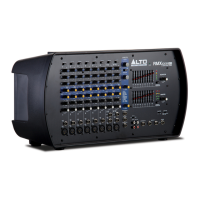5
REAR PANEL
35. POWER SWITCH – Turns the
mixer on and off. Turn on the
mixer after all input devices have
been connected and before you
turn on amplifiers. Turn off
amplifiers before you turn off the
mixer.
36. POWER IN – Use the included
IEC power cable to connect the
mixer to a power outlet. While the power
is switched off, plug the power supply into
the mixer first, then plug the power supply
into a power outlet. Please check the
voltage available in your country and how
the voltage for your RMX1008DFX is
configured before attempting to connect
your RMX1008DFX to the main AC.
37. SPEAKER JACKS- These jacks are used
to connect speakers. They are configured with 4-way Speakon connectors and 1/4" phone jacks. You
can determine the signal that is output to these jacks according to the setting of the AMPLIFIER MODE
select switch.
Note: In order to avoid damage to the built-in amplifier, please pay attention to the allowed
impedance of the speaker. Very low load impedances may damage the amplifier. Look at the
plate on the back of your unit for reference.
!
Caution: Do not connect the rear panel speaker level ¼” outputs to anything other than a passive
loudspeaker. Connecting this output to a line line/Mic level input may damage your equipment.
* WARNING: Units bought in the US are preset to
US voltage. Units purchased in EU/UK are preset
to 220/240 voltage. Adjustment should not be
made unless you’re traveling to other countries or
are in a country with varying voltage. Selecting an
improper voltage can damage the unit.
35
36
37
37

